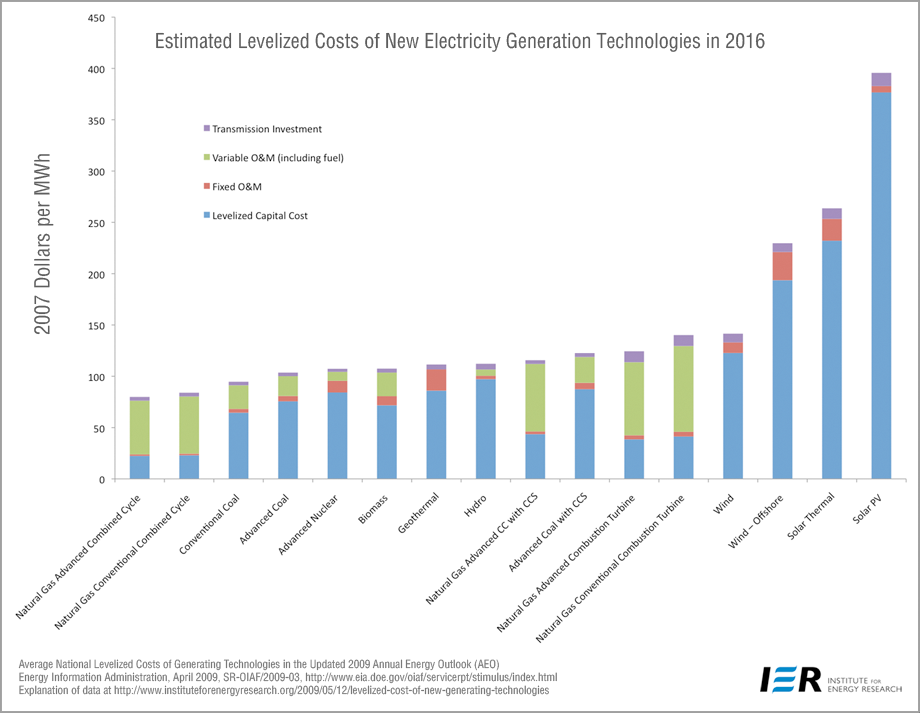Alvin Weinberg differentiated between Social Engineering and technological fixes. Weinberg offers a definition of a Technological fix.
A technological fix is a means for resolving a societal problem by adroit use of technology and with little or no alteration of social behavior.Social Engineering would be an approach that focuses on changing human behavior. Almost everyone who writes about energy advocates some technological fix. For example, renewable advocates prefer the use of wind or solar technology to provide energy for society. There are, however, significant problems with these technologies. They are expensive, and in in significant ways unreliable. Further technological fix is required for the unreliability problems, and those fixes are also expensive.
Most advocates of renewable energy argue that efficient use of energy can compensate for the inefficiencies of solar and wind generated electricity. Allegedly, greater energy efficiency is low hanging fruit, and great demand reductions can be accomplished by relatively trivial investments in energy efficiency.
The problems with the renewable energy/energy efficiency paradigm is simple, people lack motive to adopt it. If as many scientist claim we need to replace something like 80% carbon sourced energy by 2050 we need routes that will get us there, but to date there seems to be no natural route that will lead us to that replacement. Hence renewables advocates are forced to fall back onto a social engineering approach to carbon mitigation. Yet resorts to social engineering carry with them problems and unintended consequences as Weinberg pointed out over 30 year ago.
It is significant that so much of the discussion has been concernedWeinberg pointed to the unintended consequence of the social engineering approach.
with supply rather than demand. Again, this is natural since demand ordinarily involves individual actions of many consumers, whereas supply embraces far fewer, but more powerful actors. In principle, it is easier to increase the efficiency of a central station power plant - say by installing low Btu gas topping cycles - than it is to persuade millions of people to turn off their lights or to insulate their homes. In the one case - increasing efficiency of supply - the ultimate consumer has little reason to change his style of living; in the other case, his customary habits are intruded upon, and he must readjust at least some of his ways of doing things.
I would suggest that the primary adjustment imposed by social rather than technological approaches to reduction in demand is a loss in our freedom to allocate time. . . .Weinberg's views were amazingly prophetic, and accurately reflect out current situation. And Weinberg anticipated critiques of his position,
Much of the current rumble about soft energy paths - which implies small, decentralized generating systems based largely and ultimately on the sun, as wel l as upon a myriad of individual social decisions - involves sacrificing time, or at least freedom in our allocation of time, in the interest of saving our scarce resources of oil and gas. of the inherent intermittency of the sun. This sacrifice of time is a consequence mainly of the inherent intermittency of the sun.
Social critics tend to be wary of technological fixes because they do not get to root causes . . .However, as Weinberg points out,
Most technological fixes can do no more than help remedy the immediate problem that invoked the fix. In their wake they leave other problems which, in turn, are amenable to resolution by additional technological fixes: fixes are applied over fixes, and the society, to be metaphorical., becomes a patchwork of band-aids -indeed, I have referred to it as the "band-aid society".
But technological fixes are not unique in this regard for, if we are honest, social fixes also have unforeseen and deleterious side effects. On a grand scale, we have the Marxism, which has brought in great revolutionary movements - for example, its wake massive suffering. . . .Weinger's solution to the problem of energy is also the technological fix that I endorse:
one must concede that neither technological nor social fixes can ever be expected to produce utopia here on earth: our society, I believe, will always be a band-aid society - about all we can hope for is that small l incremental improvements, taken as a whole, will lead to happier,
more fulfilled people.
constitutes a possible technological fix for the underlying, long-term
nuclear energy, at least in its breeder embodiment, problem of energy I believe is undeniable - this, despite the current disaffection with nuclear energy and rejection of at least some breeder reactors.












